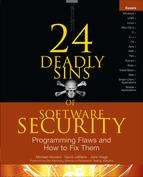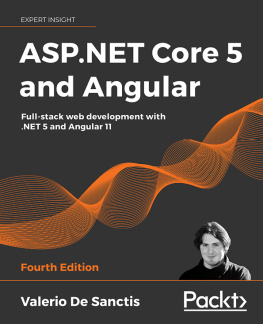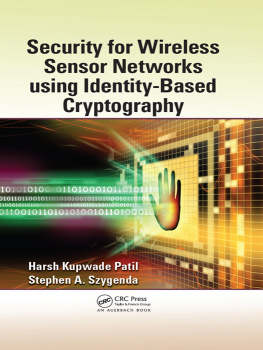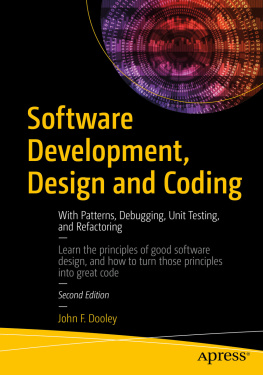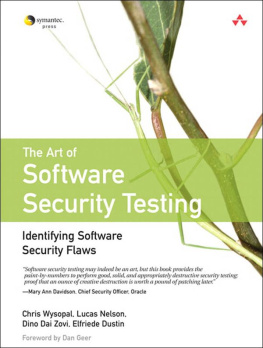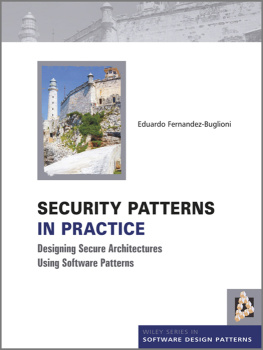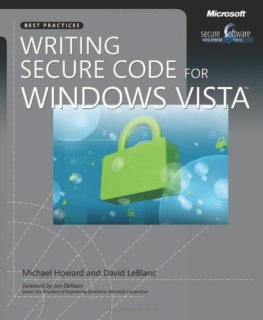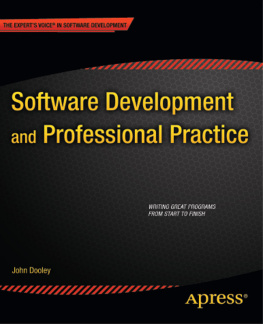24 DEADLY SINS OF SOFTWARE SECURITY
Programming Flaws and How to Fix Them
Michael Howard, David LeBlanc, and John Viega


Copyright 2010 by The McGraw-Hill Companies. All rights reserved. Except as permitted under the United States Copyright Act of 1976, no part of this publication may be reproduced or distributed in any form or by any means, or stored in a database or retrieval system, without the prior written permission of the publisher.
ISBN: 978-0-07-162676-7
MHID: 0-07-162676-X
The material in this eBook also appears in the print version of this title: ISBN: 978-0-07-162675-0, MHID: 0-07-162675-1
All trademarks are trademarks of their respective owners. Rather than put a trademark symbol after every occurrence of a trademarked name, we use names in an editorial fashion only, and to the benefit of the trademark owner, with no intention of infringement of the trademark. Where such designations appear in this book, they have been printed with initial caps.
McGraw-Hill eBooks are available at special quantity discounts to use as premiums and sales promotions, or for use in corporate training programs. To contact a representative please e-mail us at bulksales@mcgraw-hill.com.
Information has been obtained by McGraw-Hill from sources believed to be reliable. However, because of the possibility of human or mechanical error by our sources, McGraw-Hill, or others, McGraw-Hill does not guarantee the accuracy, adequacy, or completeness of any information and is not responsible for any errors or omissions or the results obtained from the use of such information.
TERMS OF USE
This is a copyrighted work and The McGraw-Hill Companies, Inc. (McGraw-Hill) and its licensors reserve all rights in and to the work. Use of this work is subject to these terms. Except as permitted under the Copyright Act of 1976 and the right to store and retrieve one copy of the work, you may not decompile, disassemble, reverse engineer, reproduce, modify, create derivative works based upon, transmit, distribute, disseminate, sell, publish or sublicense the work or any part of it without McGraw-Hills prior consent. You may use the work for your own noncommercial and personal use; any other use of the work is strictly prohibited. Your right to use the work may be terminated if you fail to comply with these terms.
THE WORK IS PROVIDED AS IS. McGRAW-HILL AND ITS LICENSORS MAKE NO GUARANTEES OR WARRANTIES AS TO THE ACCURACY, ADEQUACY OR COMPLETENESS OF OR RESULTS TO BE OBTAINED FROM USING THE WORK, INCLUDING ANY INFORMATION THAT CAN BE ACCESSED THROUGH THE WORK VIA HYPERLINK OR OTHERWISE, AND EXPRESSLY DISCLAIM ANY WARRANTY, EXPRESS OR IMPLIED, INCLUDING BUT NOT LIMITED TO IMPLIED WARRANTIES OF MERCHANTABILITY OR FITNESS FOR A PARTICULAR PURPOSE. McGraw-Hill and its licensors do not warrant or guarantee that the functions contained in the work will meet your requirements or that its operation will be uninterrupted or error free. Neither McGraw-Hill nor its licensors shall be liable to you or anyone else for any inaccuracy, error or omission, regardless of cause, in the work or for any damages resulting there from. McGraw-Hill has no responsibility for the content of any information accessed through the work. Under no circumstances shall McGraw-Hill and/or its licensors be liable for any indirect, incidental, special, punitive, consequential or similar damages that result from the use of or inability to use the work, even if any of them has been advised of the possibility of such damages. This limitation of liability shall apply to any claim or cause whatsoever whether such claim or cause arises in contract, tort or otherwise.
To Jennifer, who has put up with many days of my working on a book, and to Michael for improving my writing skills on our fifth book together.
David
To my family for simply putting up with me, and to David as he continues to find bugs in my code!
Michael
ABOUT THE AUTHORS
Michael Howard is a principal security program manager on the Trustworthy Computing (TwC) Groups Security Engineering team at Microsoft, where he is responsible for managing secure design, programming, and testing techniques across the company. Howard is an architect of the Security Development Lifecycle (SDL), a process for improving the security of Microsofts software.
Howard began his career with Microsoft in 1992 at the companys New Zealand office, working for the first two years with Windows and compilers on the Product Support Services team, and then with Microsoft Consulting Services, where he provided security infrastructure support to customers and assisted in the design of custom solutions and development of software. In 1997, Howard moved to the United States to work for the Windows division on Internet Information Services, Microsofts web server, before moving to his current role in 2000.
Howard is an editor of IEEE Security & Privacy, is a frequent speaker at security-related conferences, and regularly publishes articles on secure coding and design. Howard is the co-author of six security books, including the award-winning Writing Secure Code (Second Edition, Microsoft Press, 2003), 19 Deadly Sins of Software Security (McGraw-Hill Professional, 2005), The Security Development Lifecycle (Microsoft Press, 2006), and his most recent release, Writing Secure Code for Windows Vista (Microsoft Press, 2007).
David LeBlanc, Ph.D., is a principal software development engineer for the Microsoft Office Trustworthy Computing group and in this capacity is responsible for designing and implementing security technology used in Microsoft Office. He also helps advise other developers on secure programming techniques. Since joining Microsoft in 1999, he has been responsible for operational network security and was a founding member of the Trustworthy Computing Initiative.
David is the co-author of the award-winning Writing Secure Code (Second Edition, Microsoft Press, 2003), 19 Deadly Sins of Software Security (McGraw-Hill Professional, 2005), Writing Secure Code for Windows Vista (Microsoft Press, 2007), and numerous articles.
John Viega, CTO of the SaaS Business Unit at McAfee, is the original author of the 19 deadly programming flaws that received press and media attention, and the first edition of this book is based on his discoveries. John is also the author of many other security books, including Building Secure Software (Addison-Wesley, 2001), Network Security with OpenSSL (OReilly, 2002), and the Myths of Security (OReilly, 2009). He is responsible for numerous software security tools and is the original author of Mailman, the GNU mailing list manager. He has done extensive standards work in the IEEE and IETF and co-invented GCM, a cryptographic algorithm that NIST has standardized. John is also an active advisor to several security companies, including Fortify and Bit9. He holds an MS and a BA from the University of Virginia.
About the Technical Editor
Alan Krassowski is the Chief Architect of Consumer Applications at McAfee, Inc., where he heads up the design of the next generation of award-winning security protection products. Prior to this role, Alan led Symantec Corporations Product Security Team, helping product teams deliver more secure security and storage products. Over the past 25 years, Alan has worked on a wide variety of commercial software projects. He has been a development director, software engineer, and consultant at many industry-leading companies, including Microsoft, IBM, Tektronix, Step Technologies, Screenplay Systems, Quark, and Continental Insurance. Alan holds a BS degree in Computer Engineering from the Rochester Institute of Technology in New York. He currently resides in Portland, Oregon.

